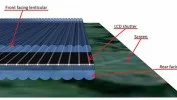We recently featured a press release from 3D Tau on our Display Daily mail-out. Our friend, Dr. Jon Peddie, had a closer look and sent us this article…
Stereo 3D, or S3D as we like to call it, got rejuvenated around 2009 when TV set manufacturers started introducing products, some glasses-free, some with glasses. The first S3D TV was actually developed in August 1928, by John Logie Baird using electro-mechanical and cathode-ray tube techniques. And the first manufactured 3DTV was introduced in 1935.
IFA, IBC, NAB 2010 and CES were all about S3D TV, and the excitement continued until about 2012, with a few whispers in 2013, but effectively dead, done, and gone – no 3DTV for you, mister.
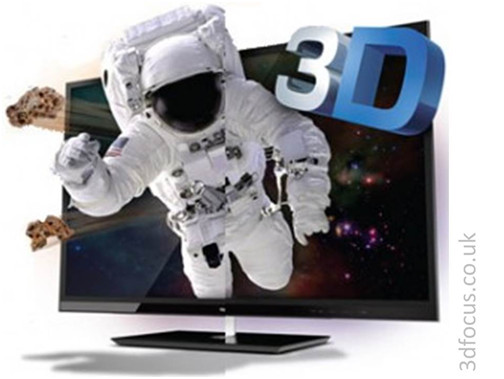 The list of problems and issues never got shorter, too dark, too dorky with glasses, incompatibility between manufacturers, dead-zones with glasses-free TVs, and crappy content from studios that never understood how to use 3D to augment a story, and only used it for shock effect. Shock-effect gets old real fast.
The list of problems and issues never got shorter, too dark, too dorky with glasses, incompatibility between manufacturers, dead-zones with glasses-free TVs, and crappy content from studios that never understood how to use 3D to augment a story, and only used it for shock effect. Shock-effect gets old real fast.
In 2009, Paris-based Alioscopy introduced a glasses-free lenticular lens TV using some technology licensed from Philips. Alioscopy created content using eight or more cameras, with the idea of minimizing the dead-spot, and the demos we saw at the time looked good. If you looked for it, and we did, you could still find a dead spot, but it was not nearly as annoying as a simple two-camera production.
Six years later, after the great crash of S3D, some erstwhile engineers at 3D Tau in Vilnius, Lithuania developed the next generation of a multi-POV glasses-free 3S3D display, which they call the Stereo-Step-Eclipse (SSE).
Unlike the existing developments, 3D Tau claims its solution provides any number of freely positioned viewers to see a 3D image. The 3D experience is achieved through a design which is based on an optical screen image sequence processing scheme.
The SSE technology is designed to be embedded directly into a new generation of displays. The company also claims the implementation can be achieved as an attachment to the existing off-the-shelf 2D-screens of all types.
The SSE system directs each view into a separate narrow field of observation. A viewer sees different views from different positions. Each eye registers a different view and the viewer sees the scene in 3D. The image below shows a simplified schema of the SSE system.
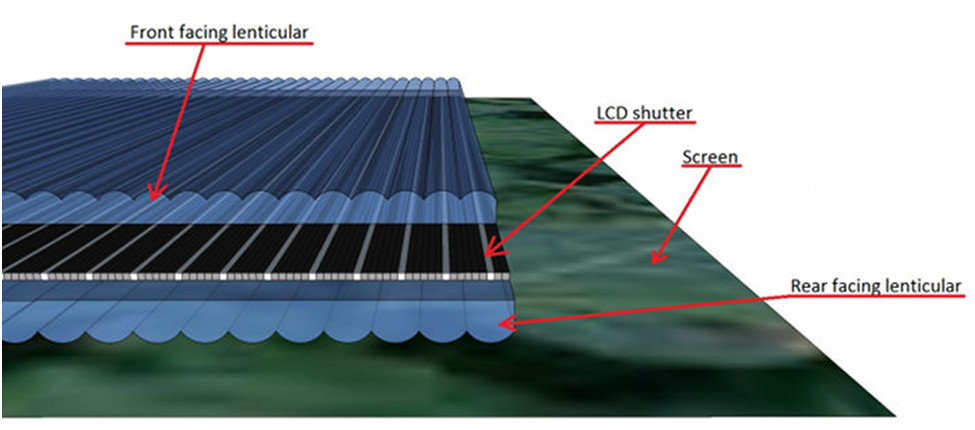 The display shows series of different angles. (Source 3D Tau)
The display shows series of different angles. (Source 3D Tau)
The rear facing lenticular focuses the full screen view onto the front LCD layer (LCD shutter). Synchronously to the exposed view, the front LCD layer opens narrow gaps and the focused screen light goes through these gaps to the front facing lenticular. This lenticular directs the view into a certain direction which is synchronized to the view.
 During the demonstration, each angle was separated (in compressed fragments) in fixed slits and instantly directed by lenticular lens to the spectator area. (Source 3D Tau)
During the demonstration, each angle was separated (in compressed fragments) in fixed slits and instantly directed by lenticular lens to the spectator area. (Source 3D Tau)
The SSE video stream consists of separate sets of frames (images/frames). Each frame represents a certain perspective of a scene. In each such set the synchronous perspectives of the same scene are displayed in uniform manner (by quantity and order), and each next set of the video stream corresponds to the following/next moment of the same scene, or is a set of perspectives of the next (new) scene.
Original frames of the scene are obtained by taking a picture (using a camera/video recorder) or generated using computer graphics/video editors. Positions for real or generated imagery are chosen so that parallax between perspectives would be the same. Generally, the original (obtained by taking picture/video or generated) content is processed on a computer in accordance with a script, instructions of a film director or video format requirements. After this processing, the content is considered ready for broadcasting on existing networks (cable, radio broadcasting) and for direct display (demonstration) on the screen. The final content is transferred to storage media.
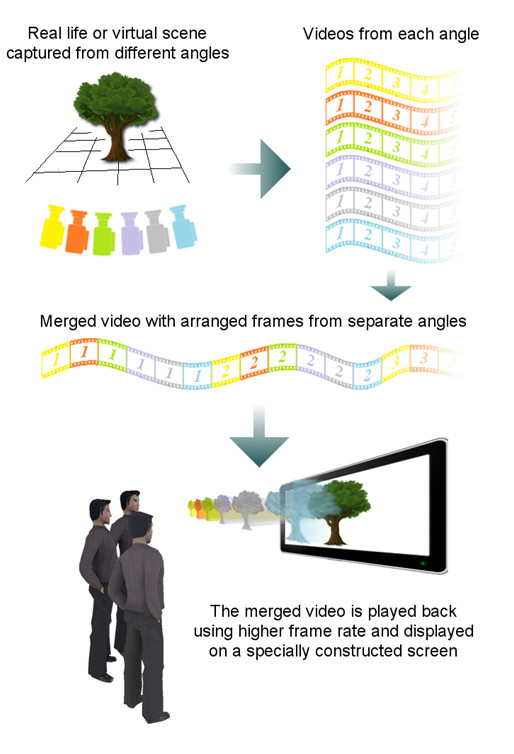 How the technology works. (Source 3D Tau)
How the technology works. (Source 3D Tau)
The Stereo-Step-Eclipse technology uses multiple cameras to capture the scene from different angles. The cameras have fixed position in respect to each other. The viewing angle between two or more cameras can be arranged using software.
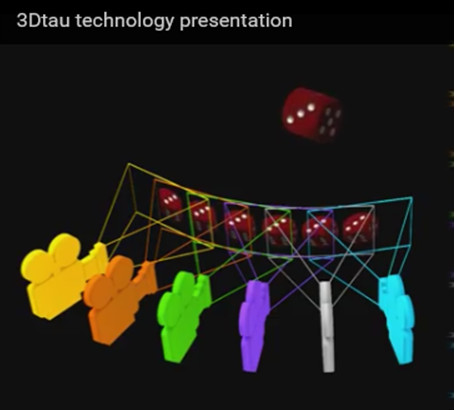 3D Tau uses multiple cameras to decrease the size of the sweet-spot (Source 3D Tau)
3D Tau uses multiple cameras to decrease the size of the sweet-spot (Source 3D Tau)
The frames from the captured videos are merged into a single video using the following frame sequence:
• Frame 1 from the 1st camera, frame 1 from the 2nd camera, …, frame 1 from the last camera;
• Frame 2 from the 1st camera, frame 2 from the 2nd camera, …, frame 2 from the last camera;
• …
• Final frame from the 1st camera, final frame from the 2nd camera, …, final frame from the last camera.
The company says the resulting video can be played back using correspondingly higher frame rate (6 times higher speed for the six camera configuration) and displayed on a specially constructed screen.
The company says that in addition to showing images in 3D, the optical scheme can be used for augmented reality applications, when real and virtual objects are shown on the same screen simultaneously. Therefore, it provides new opportunities in video graphics content with applications in motion pictures, TV, advertising and presentation, entertainment, education, scientific modeling, video gaming, industrial, transportation and military simulators, topographical maps and visual aids for navigation systems, avionics etc.
The optical scheme can also enable dedicated views for multiple viewers, when every viewer sees their specific content on the shared screen. Aside from the obvious applications in advertising, entertainment and surveillance systems, this mode solves a problem in the area of avionics instrumentation. For example, each member of an aircraft crew can see their specific data on the same dashboard screen.
The company says the technology is available now for license. www.3dtau.com
Analyst Comment
What does Dr Jon think?
3D Tau has developed a multi-view lenticular lens display technology with resolution recovery.
It uses two lenticular lenses, one in front of an LCD with a shutter (like a TN panel) between the two lenticular lenses. There are slits that turn on and off behind each. As different images are displayed on the pixel columns, different slits become transparent. The lenticular lenses direct light from different pixels through the slits to different viewing zones. Variations in the design could produce different numbers of viewing zones.
Their current prototype uses a stationary slit barrier and vibrates the front lenticular lens back and forth to direct light to different viewing zones. In their video it flickers, but they say they can solve that. It also seems to produce some sort of moiré effects at the edges of the image.
It is not a product – they have a prototype and technology which they are applying for a patent on, and they want to license it.
The disadvantages of this scheme are:
- A tremendous loss of light. This cuts back even more light than a static slit barrier, over twice as much. For example a nine view display could block over 95% of the light coming out of the LCD.
- To get N number of views they have to run the display at 60 X N fps. They probably can’t take advantage of the interleaving effect that DTI3D does in their resolution recovery for multi-view displays, which cuts down on the frame rate.
- Though we have not seen this display, we can speculate that the following is true:
The double lenticular lens scheme will tend to produce the same type of color fringing as a normal lenticular lens. And with double lenticular lenses it will be difficult to make the lenses focus well and get a good image.
Jon Peddie

